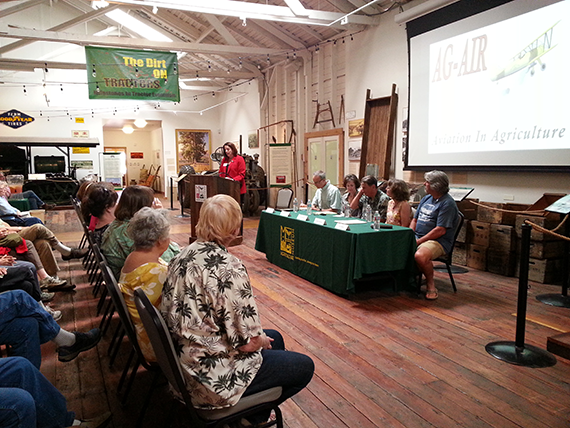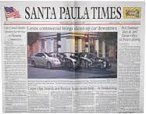The panel discussion began with Stefanie Davis, Director of Marketing, introducing the event and saying a couple words about the exhibit. Davis introduced the panelists by “roasting” them as a joke. The panelists included Rob Scherzinger, Kevin Miskel, Marie Murray, Janice Dickenson and Mitch Stone.
Kevin Miskel, pilot for Aspen Helicopters, was the first to speak. He’s been crop dusting since 1989 and described what it’s like to fly so low while crop dusting.
“I’ve been flying for a long time and I plan to be doing it for a long time longer,” Miskel said. “Helicopters have the maneuverability to get in the field, small fields, make the tight turns around wires, and things like that.”
Miskel also shared a story about when he was flying. A buzzard flew straight through his windshield and hit him in the chest. The bird survived and Miskel was fine.
Janice Dickenson, granddaughter-in-law of Ralph Dickenson, followed by talking about how Ralph Dickenson bought a hangar, airplane, and was the first recognized pilot in Santa Paula. Ralph would go on to raise $19,000 in two weeks and help open the Santa Paula Airport in 1930.
Rob Scherzinger, founder of Aspen Helicopters, told his story about how he started at Ventura College, went to flight school in the army, and left after seven years. He wanted to continue flying and has been crop dusting since 1979. Scherzinger is also one of the last two crop dusters left in the county, the other is Miskel.
“When you get done spraying a crop or field you know right away if you’ve done a good job or a really bad job,” Scherzinger said. “We work really hard in the summer time and it’s one of those things where you can’t wait to get out of the helicopter, but when you’re out of it for a few days you can’t wait to get back in it. It’s a lot of fun, but it’s a lot of work.”
Marie Murray, daughter of local legend and Ag pilot, PJ Murray, talked about her father and how while “growing up, flying seemed second nature.” Murray said she still loves to see crop dusters and that her father always said, “We do whatever it takes to bring the crops in.”
Mitch Stone, a noted historian of Santa Paula and Ventura County, was the last to speak on the panel. Stone’s been studying Santa Paula’s history closely for the last 30 years and also described Santa Paula’s airport and how it came to fruition with the St. Francis dam tragedy. The accident allowed farmers to buy the land cheaply which would end up becoming the airport. He described how the airport has been privately owned since 1930 and will have a book coming out about its 85th anniversary.
“It’s a great topic for aviation and Santa Paula. It’s something we don’t talk about very much, our direct connections with agriculture.” Stone said. “Aviation is really woven into the history of Santa Paula so anything that has to do with that is important.”
A Q&A session followed the panel discussion which lasted about 20 minutes. Visitors asked what Scherzinger was crop dusting with, if they’ve helped with the current oil spill, past pilots from the 1980s, and even what their favorite pests are.
Eric Howes, exhibits design and curator, had the challenge of researching and putting the exhibit together. Much of the local history is not in print, so Howes had to reach out to the aviation agricultural community to hear the stories. He had no idea who any of the men were but after hearing all the stories he said he felt like he knew them and thought it was incredible what people like PJ Murray did for aviation agriculture. From start to finish, the exhibit took Howes about four months to complete which included graphic design and floor layout.
“[The panel discussion] gives people one-on-one actual physical connection with this. Instead of just standing there looking at a wall you can actually reach back into history and actually learn firsthand from these people. It’s a big opportunity.” Howes said. “I thought, aircraft and agriculture are inextricably linked and it hasn’t ever been highlighted here. I also know that everybody loves airplanes! I knew people would enjoy it and bring in a younger crowd because I want the younger generation to understand what this stuff really is.”
Howes said he was more than satisfied with the exhibit and that, “it did what I wanted it to do.” He installed a wall of corrugated metal which created an aircraft hangar vibe from the 1930s. It also divided the space to make the exhibit more intimate while allowing for more items to be placed on the new wall.
Just over 50 people were in attendance for Ag Air and, as the panelists were getting ready, more chairs had to be brought in because people continued walking in. Ag Air: Aviation in Agriculture opened June 20 and is slated to run until February 29. It’s already had 459 visitors and continues to attract more each week.



